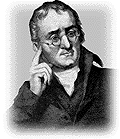
Home
Common Compounds
Exam Guide
FAQ
Features
Glossary
Construction Kits
Companion Notes
Just Ask Antoine!
Simulations
Slide Index
Toolbox
Tutorial Index
Companion Notes
Introduction
Measurement
Matter
| Atoms & ions |
Chemical change
The mole
Gases
Energy & change
The quantum theory
Electrons in atoms
The periodic table
Home  Companion Notes Companion Notes  Atoms & ions Atoms & ions | Print | Comment |

 We might as well attempt to introduce a new planet into the solar system, or to annihilate one already in existence, as to create or destroy a particle of hydrogen.
We might as well attempt to introduce a new planet into the solar system, or to annihilate one already in existence, as to create or destroy a particle of hydrogen.
John Dalton, A New System of
Chemical Philosophy, 1808)
| Vocabulary | |
atom chemical change  hypothesis  stoichiometry  |
-
"...it became an object to determine the relative sizes and weights, together with the relative numbers of atoms entering into such combinations... Thus a train of investigation was laid for determining the number and weight of all chemical elementary particles which enter into any sort of combination one with another."
Some of the details of Dalton's original atomic theory are now known to be incorrect. But the core concepts of the theory (that chemical reactions can be explained by the union and separation of atoms, and that these atoms have characteristic properties) are foundations of modern physical science.
| Dalton's Atomic Theory | |
|
Page 1: Introduction Page 2: Dalton's assumptions Five steps forward and one step back. Page 3: Atoms in compounds An "invisible hand" fixes atom ratios in compounds Page 4: Atoms in reactions Dance of the atoms Page 5: Learning check Take a quiz on Dalton's Atomic Theory Page 6: References and resources |
newsletter describing updates,
new features, and changes
on this site.
General Chemistry Online! Dalton's atomic theory
Copyright © 1997-2005 by Fred Senese
Comments & questions to fsenese@frostburg.edu
Last Revised 02/23/18.URL: http://antoine.frostburg.edu/chem/senese/101/atoms/dalton.shtml